Mediasonic Probox 8-bay 3.5" USB 3.0 / eSATA DAS Review
by Ganesh T S on August 4, 2012 7:55 AM ESTPerformance Benchmarks:
In order to evaluate the performance of the enclosure, we used SSDs under the impression that they would deliver better performance compared to HDDs. We mentioned initially that the Probox doesn't support 2.5" drives. However, with careful manual handling, 2.5" SSDs could be connected to the internal ports with the unit laid sideways (to avoid the SSDs hanging off the internal SATA connectors).
The following IOMeter benchmarks were run in both eSATA and USB3 mode for configurations involving disks in 1, 2, 4 and 8 bays.:
- 128K Sequential Accesses with a queue depth of 1
- 4K Random Accesses with a queue depth of 3
- 4K Random Writes with a queue depth of 32
Despite my intent to benchmark all possible configurations for both eSATA and USB3, I found that the P8H77-M Pro's eSATA port would BSOD frequently whenever we had more than 2 drives being accessed using its port multiplier feature. Any missing bars in the above graph indicate that the test couldn't complete because of this issue. In fact, Mediasonic strongly recommends PCI-E add-on cards with Silicon Image 3132 / 3124 chipsets which have support for FIS based switching with port multiplier.
In addition to the above benchmarks, we also ran the DiskBench tests that we use in the NAS reviews. The graphs below present the results obtained in the four tests.
One of the main issues I found with SSDs was the increase in I/O response time when multiple disks were being simultaneously accessed through IOMeter. I found this mainly during access through USB 3.0. The issue may be present even in the eSATA configuration, but I am unable to confirm it due to the port multiplier issue.
In the configurations under which eSATA worked, it seems to have a steady increase in performance as more disks are accessed. Through USB 3.0, however, the performance seemed to plateau very soon. Was this something specific to SSDs or would it manifest itself even with HDDs? The next section tries to analyze this further.


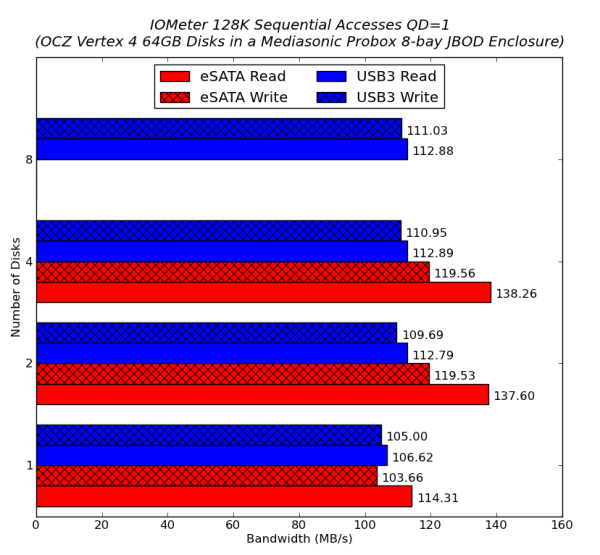
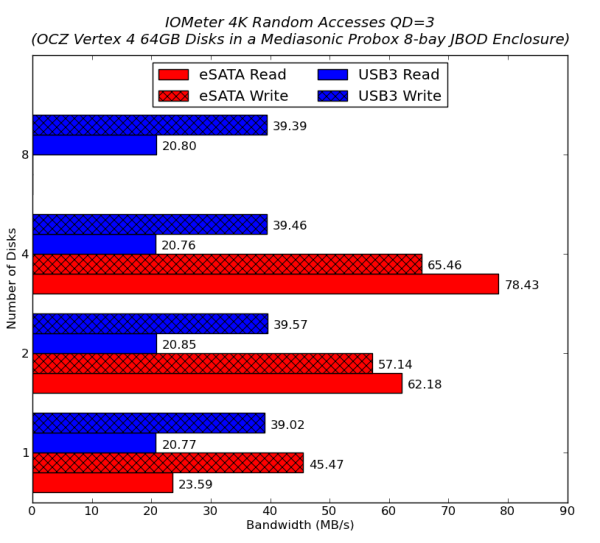
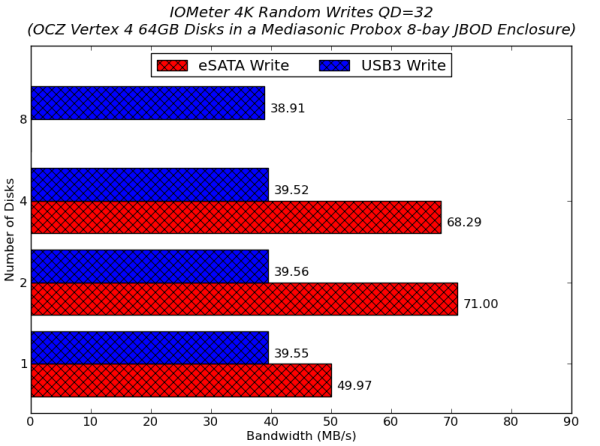
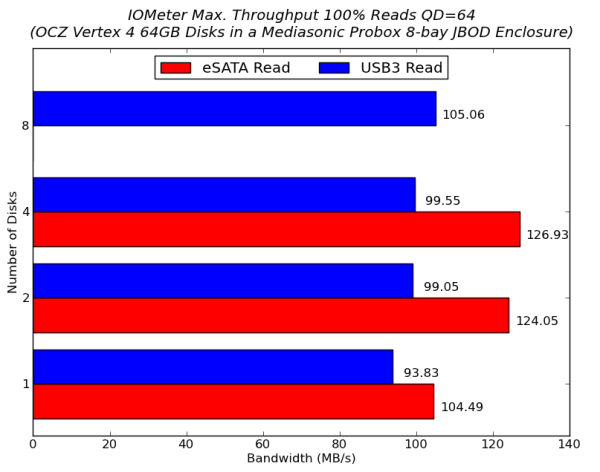

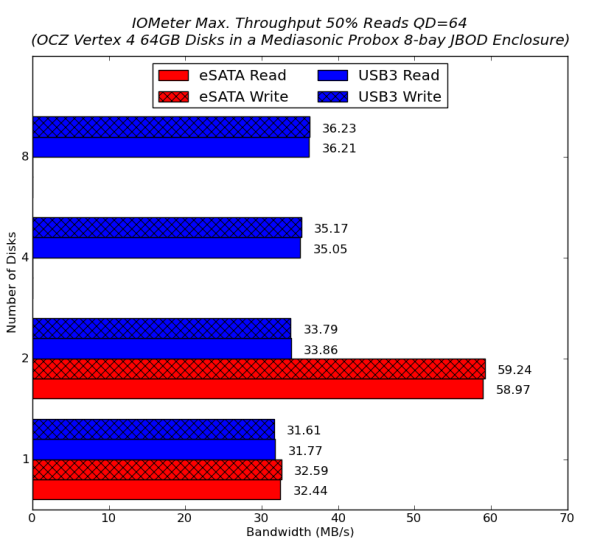
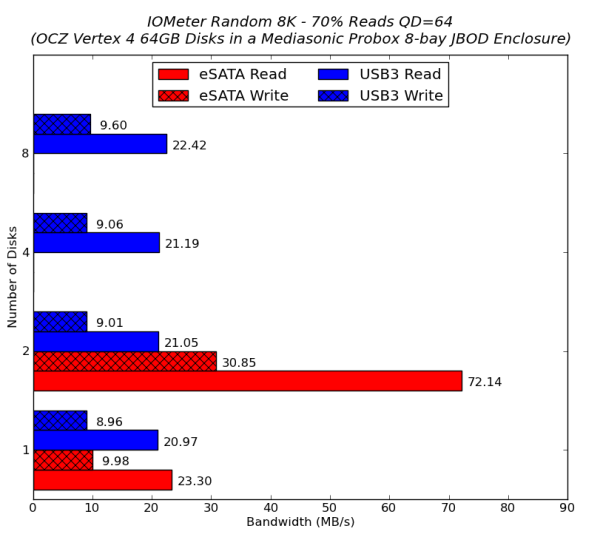








48 Comments
View All Comments
rahvin - Monday, August 6, 2012 - link
It's been my experience that if there are drivers in Linux (and these days there almost always is) then they absolutely smoke windows for reliability and quality. The advantage of Linux is that you don't have low bid foreign programmers building drivers in as little time as possible with absolutely no QC like you do in windows. Almost all windows BSOD (or GSOD depending on windows version) is the result of bad drivers.yyrkoon - Tuesday, August 7, 2012 - link
Been running USB3 on Windows7 enterprise x64 now for 6-8 months. First, on a laptop through expresscard, and now naively on a laptop that has it on the motherboard.Two different systems, two completely different platforms(1 Intel, 1 AMD ). No issues what-so-ever.
No hands on with Linux and USB3, but I have to call BS on your performance comment. Having been using Linux in some form or another since the late 90's, I hear / see this kind of comment all the time. With no substantial proof to back it up.
Plus I have done tons of my own performance testing to boot. Using iSCSI, AoE, Samba, and NFS. On both software platforms. It all came down to very similar performance on both platforms. This is also where I ran into a lot of stability issues with Ubuntu. E.G. Some of the software I was using was very obviously not ready for prime time on Ubuntu. Even though Ubuntu was at the time the most advanced Debian flavored Distro.
So, you see I could say the exact same about Linux. If I wanted to.However, I wont. Simply because I know that the software was not ready for that platform at the given time. Even though it was touted as being ready. This was also more than a couple years ago. I am sure things have improved at least somewhat since then.
Now days, knowing what I know. I would probably bypass Linux for this purpose all together. And jump straight into openSolaris. That would be my own choice though.
rahvin - Thursday, August 9, 2012 - link
[blockquote]Even though Ubuntu was at the time the most advanced Debian flavored Distro.[/blockquote]Wow, that says it all right there doesn't it. I'd be surprised if you understand the difference between the kernel and distribution or performance versus stability and quality given that comment.
Try starting with this thought, Linux is the Kernel. GNU/Linux is the base GPL system that makes up the base system environment and userland (an alternative to this would be Android with a different system and base written from scratch by google on top of a Linux kernel). A distribution is a combination of GNU/Linux system and userland along with a multitude of other software with varying amounts of free software but typically comprising the X-Window system and a selection of standard FOSS applications though certain distributions include proprietary or non-free components. Ubuntu has NEVER been "the most advanced Debian distribution" unless you are creating your own definition of advanced that doesn't match the standard definition.
Installing Linux and playing around with it for five minutes every now and then doesn't mean you've done anything but experiment with it. I'm by no means an expert but I've been running a Linux system continuously since about 1998. In that time I've had one kernel oops (the rough equivalent of a windows BSOD) and that was due to me screwing up a kernel replacement. In that same time period on other systems I've had a multitude of windows BSOD's. I've never encountered a situation where a closed source windows driver was better in any way than an open source driver in Linux and I doubt anyone ever has. In fact Valve recently discovered that their Source Engine designed and built for Windows and DirectX performed better on Linux with FOSS drivers in OpenGL and in fact was something like 40% faster.
bobbozzo - Sunday, August 5, 2012 - link
OpenFiler Linux works with PM SATA, depending on the host controller, of course.PubFiction - Sunday, August 5, 2012 - link
In reality most of the many of the devices are both DAS and NAS. But at the same time I think that NAS still makes alot more sense. The type of people who are using that much data are usually interested in serving it to more than 1 machine, be it a media center, small company, family etc.... I think that in reality DAS was just a relic of all those people who did not have a network or had no idea how to set them up. But as time went on routers with 4 wired / 4 wireless connections became unavoidable and people who now connected xboxes, phones, tablets and everything else to thouse routers have now become used to that process. Now they just dont have much of a need for DAS. And I thin that trend will continue unless networks fall very far behind in bandwidth and somehow the content generated sky rockets.yyrkoon - Tuesday, August 7, 2012 - link
Just because the DAS only connects to one system, does not mean that it can not be shared over a network.Key points in favor of DAS over a NAS are flexibility, performance, and power consumption. Not necessarily in that order.
A DAS could also be used to expand on an already full NAS for that matter . . . This is how SAS, iSCSI, and a lot of other external drives can be / are used.
kmmatney - Wednesday, August 8, 2012 - link
I guess it depends on the user, but I don't see this as being useful. I built a cheap Windows Home Server box, with 6 SATA ports, for less than $200 (using a few spare parts), and have used drive extender to easily add storage space over the years. It acts as a media server (via Serviio), and automatically backs up 6 PCs in the house. I can access files from the internet as well. I can add external USB hard drives to expand the storage pool as well, so there's room to add more drives beyond the 6 SATA port on the motherboard.ypsylon - Monday, August 6, 2012 - link
And I have no more interest in this. Probably worst storage chipset ever created. Furthermore who need 8 bay JBOD enclosure? No redundancy, just buy bigger case if you need so many HDDs without any protection. And those plastic handles. C'mon plastic!?! Tiny bit of aluminum wouldn't hurt. Like many of such enclosures it is cheap to the extreme - Chinese copy of a copy of a copy. Nobody really knows who is the author of this design.As for opinion (above) that DAS is a relic and NAS is more logical choice. LOL have you ever tried to copy TBs of data every single day over Ethernet? Obviously not. I don't need network, but I do copy plethora of things each day. I would die of boredom while waiting if I used (even 10Gb) NAS. DAS all the way on my front but with NICs at the back if sometimes network is needed.
Both DAS and NAS have space on the market, but both are completely pointless when no redundancy is present (excluding of course single drive mobile enclosures ;) ).
yyrkoon - Tuesday, August 7, 2012 - link
I agree with you on the NAS / DAS comment above lol.Anyhow not trying to talk you into liking this tower. But read newegg reviews on it. Some people actually seem to like the plastic case door etc. While others hate it. But I do agree with you.
Another thing I do not like about it is that it is a single wide tower. In my own humble opinion, this is retro, or just old. Sure these could fit into a 1U rack, but why not come up with something new ? Like a double wide ( heh ) 4 bay high tower ? Personally, I would find that more attractive If this is done, then you open up a whole new area of cooling options. 1-2x 120mm fans in the front . . .etc etc.
Yeah anyway. I dont know. it seems people in the industry have lost, or never had any imagination.
PureHazard - Wednesday, August 8, 2012 - link
The plastic handles are meant to dampen the noise from hard drive vibration after being squeezed in by the metal swing door. I would assume aluminum handles wouldn't make sense for noise reduction.As for it being cheap, this is a Taiwanese made enclosure that's built by Hotway (as mentioned in the review if you cared to read it properly) and as sturdy any enclosure from a tier one manufacturer.
These 4 and 8 bay DAS enclosures complement existing servers and things like prebuilt WHS machines fairly well.